Preface
Contents
Contributors
Robust Digital Computation in the Physical World
1 Introduction
2 Limitations of Digital Models in an Analog World
2.1 Introduction
2.2 Physics of Hybrid Modeling
2.3 Definition of the Thermostat Model
2.4 Informal Analysis of the Thermostat Model
2.5 Formal Implementation
3 Modeling and Verification of Out-of-Nominal Logic
3.1 Introduction
3.2 Modeling Out-of-Nominal Safety Properties
3.3 Example Turnstile Model
3.4 Design and Out-of-Nominal Verification Via Abstraction
3.4.1 Refinement (High Level)
3.4.2 Implementation (Low Level)
4 Resilience of Computational Physics Simulation
4.1 Introduction
4.2 Methodology
4.2.1 Operations in PDE Solvers
4.2.2 Error Model and Mitigation Approach
4.3 Application to the Conjugate Gradient Solver
4.3.1 The Basic Conjugate Gradient Solver
4.3.2 Controlling Convergence of the CG Algorithm
4.3.3 Evaluation Using In Situ Interpolation
5 Conclusion
References
Constraint-Based Framework for Reasoning with DifferentialEquations
1 Introduction
2 Preliminary Notions
2.1 Numerical Constraint Satisfaction Problems
2.2 Branch-and-Contract Solving Method
2.3 Some Limitations on NCSP
2.3.1 Equality Constraints
2.3.2 Differential Constraints
3 Set-Based Constraint Satisfaction Differential Problems
3.1 Dynamical Systems
3.2 Set-Based Constraints
3.3 Set-Based Differential Constraint Satisfaction Problems
4 Solving SCSDP
4.1 Interval-Based Constraints
4.2 Interval-Based Differential Constraints
4.2.1 Outer Approximation of Differential Constraints
4.2.2 Inner Approximation of Differential Constraints
4.3 Revisiting Branch-and-Contract Solving Method
4.3.1 Contraction
4.3.2 Propagation
5 Numerical Example
6 Conclusion
References
Approximate Computing and Its Application to Hardware Security
1 Introduction
2 Approximate Circuit
2.1 Approximate Adders
2.2 Approximate Multipliers
2.3 Approximate Dividers
3 Approximate Software/Algorithm
4 Approximate Computing for Hardware Security
4.1 Security Primitives Based on Approximate Computing
4.1.1 Floating-Point Format with Embedding Security
4.1.2 Approximate Computing with Embedded Security Information
4.2 A Low-Voltage Approximate Computing Adder for Authentication
5 Future Research Directions
5.1 PUFs and SCAs
5.2 SCAs
5.3 Hardware Trojans (HTs)
5.4 Approximate Arithmetic Circuit for Logic Obfuscation
6 Conclusion
References
Mathematical Optimizations for Deep Learning
1 Introduction
2 Pruning
3 Quantization
3.1 Binary Weights
3.2 Binary Weights and Activations
4 Weight Sharing and Compression
4.1 Weight Sharing
4.2 Compression
5 Model Distillation
6 Filter Decomposition
7 Conclusion
References
A Zero-Entry Cyber Range Environment for Future Learning Ecosystems
1 Introduction
2 Limitations of Current Practice
2.1 Specific Problem Being Solved
3 Research
3.1 Research Question
3.2 Learning Science Approach
3.2.1 Simulation Experience Design Method
3.2.2 Distributed Cognition Theory
3.3 Learner Analysis
3.4 Cybersecurity Terminal Learning Objectives
4 Cyber Scorpion Design
4.1 Cyber Scorpion Learner Sketch
5 Software Environment
5.1 Cyber Scorpion Underlying Technology: Minimega
5.2 Software Development Approach
6 Learner Experience Demonstration and Lessons Learned
7 Limitations and Future Work
8 Conclusion
References
Parallel Programming in Cyber-Physical Systems
1 Introduction
1.1 Parallel Architectures
2 Parallel Programming in CPSs
2.1 Experimental Methodology
2.2 Modular Exponentiation
2.2.1 m-ary Approach
2.2.2 Slicing Approach
2.2.3 Conclusions: Modular Exponentiation
2.3 Karatsuba Multiplication
3 Conclusions
Appendix: Sequential and Basic Parallel Code for Karatsuba
References
Automatic Application of Software Countermeasures Against Physical Attacks
1 Introduction
2 Background
2.1 Side-Channel Attacks
2.2 Fault Injection Attacks
2.3 Combined Attacks
2.4 Countermeasures
2.5 Compilation of Secured Code
3 Automatic Application of Software Countermeasures
3.1 At Source Code Level
3.1.1 Side-Channel Attack Countermeasures
3.1.2 Fault Injection Countermeasures
3.1.3 Pros and Cons of Source Code Level
3.2 During Compilation
3.2.1 Side-Channel Attack Countermeasures
3.2.2 Fault Injection Countermeasures
3.2.3 Pros and Cons of Compiler Level
3.3 At Link Time/At Assembly Level
3.3.1 Side-Channel Attack Countermeasures
3.3.2 Fault Attack Countermeasures
3.3.3 Pros and Cons of Assembly Level
4 Discussion
4.1 Confrontation of Pros and Cons of the Different Levels
4.2 Future Works
5 Conclusion
References
Time-Delay Attacks in Network Systems
1 Introduction
2 Problem Setup
2.1 Network Model
2.2 Attack Model
2.3 Problem Formulation
3 Minimum Cardinality Attack Sets
3.1 Optimal Delay Attacks
3.2 Numerical Methods for Finding Optimal Attacks
4 Optimal Attack Sets and Relation with Topology
5 Conclusions
References
Attack Tree Construction and Its Application to the ConnectedVehicle
1 Introduction
1.1 Attack Trees in the Automotive Domain
1.2 Attack Tree Generation
1.3 Contributions
2 Background and Definitions
2.1 Automotive Architecture
2.2 Architectural Graph
Running Example
2.3 Graph Transformation
Example
3 Attack Graph Generation
4 Attack Tree Generation
5 Countermeasure
6 Conclusion
References
Reinforcement Learning and Trustworthy Autonomy
1 Introduction
2 Reinforcement Learning Preliminaries
2.1 Markov Decision Processes
2.2 Reinforce Method
3 Microsoft's AirSim
3.1 Overview
3.2 Python APIs
4 Reinforcement Learning in AirSim
4.1 Unreal Dynamic Environment
4.2 Python Environment Library
4.3 REINFORCE Method in AirSim
5 Increased Trustworthiness Through Visualization
5.1 t-SNE
5.2 Action Visualization
5.3 Attribution Visualization
6 Conclusion
References
Identifier Randomization: An Efficient Protection Against CAN-Bus Attacks
1 Introduction
2 State-of-the-Art CAN Protections
2.1 Controller Area Network Overview
2.2 Payload Protection
Flaws
2.3 Intrusion Detection and Prevention Systems
Flaws
2.4 Identifier Protection
Flaws
3 Solutions Based on Randomization and Their Evaluation
3.1 Principle and Formalism
3.2 Evaluation Metrics
3.2.1 Reverse-Engineering Attack
3.2.2 Replay and Injection Attacks
3.3 The IA-CAN Approach
3.3.1 Particular Case
3.3.2 Testing
3.4 Equal Intervals
3.4.1 Testing
3.5 Frequency Intervals
3.5.1 Testing
3.6 Dynamic Intervals
3.6.1 Illustrative Example
3.6.2 Testing
3.7 Arithmetic Masking
3.7.1 Testing
4 Comparison
5 Conclusion
Appendix
Entropy of Fixed Mapping
Conditional Entropy of Fixed Mapping
Entropy of Dynamic Intervals
Entropy of Arithmetic Masking
Conditional Entropy of Arithmetic
Fixed Mapping Optimality Proof
References
Public Key-Based Lightweight Swarm Authentication
1 Introduction
1.1 Related Work
1.2 Structure of This Chapter
2 Preliminaries
2.1 Fiat–Shamir Authentication
2.2 Topology-Aware Distributed Spanning Trees
2.2.1 Topology-Aware Networks
2.2.2 Mooij–Goga–Wesselink's Algorithm
3 Distributed Fiat–Shamir Authentication
3.1 The Approach
3.2 Backup Authentication
4 Security Proofs
4.1 Soundness
4.2 Zero Knowledge
4.3 Security Analysis
4.3.1 Choice of Parameters
4.3.2 Algorithmic Complexity
4.3.3 Root Causes of Authentication Failure
4.3.4 Effect of Network Noise
4.3.5 Man-in-the-Middle Attacks
5 Variants and Implementation Trade-Offs
5.1 Shorter Challenge Variant
5.2 Multiple-Secret Variant
5.3 Precomputed Alphabet Variant
5.4 Precomputed Combination Variant
6 Conclusion
References
Physical Security Versus Masking Schemes
1 Context About the Protection Problem
1.1 Nature of Computation
1.2 Combinational or Sequential?
1.3 Outline of the Article
2 Definition of t-Order Security by ISW [12]
2.1 Revisiting of ISW Definition
2.2 Ill-Formed Definition
2.3 Attack on Coron's Higher-Order Masking of Look-Up Tables [8]
2.4 Motivation for Bit-Mixing Masking Schemes
3 Analysis of the Security Issue
3.1 Hardware Case
3.2 Software Case
6502
LEON3
Analysis of the 6502 and LEON3 Codes
4 New Definition of Security Order
5 Conclusion
References
Embedded Classifiers for Energy-Constrained IoTNetwork Security
1 Sensor Nodes Empowered by SoC FPAA Devices
2 Low-Power Context-Aware FPAA Architectures
3 FPAAs as Physical Computation Devices
4 Embedded FPAA Security Concerns
4.1 Positive FPAA Security Attributes
4.2 Addressing FPAA Security Issues
5 FPAAs for Investigating IC Validation
5.1 Black Box (BB) Exam: CNS 182
5.2 Training IC Deconstruction Using FPAA BB Approach
5.3 FPAAs for Unique Functions
6 Summary and Next Directions
References
Challenges in Cyber Security: Ransomware Phenomenon
1 Spora Ransomware
2 DMA Locker Ransomware
3 WannaCry Ransomware
Applying Model-Based Situational Awareness and Augmented Reality to Next-Generation Physical Security Systems
1 Introduction
2 Model-Based Situational Awareness for Physical Security
3 A Secure Facility Meets Its Digital Twin
4 Scene: Sunday, 1600. Somewhere in the Countryside…
4.1 A Digital Twin Saves the Day
5 Toward Digital Twin
6 Conclusion
References
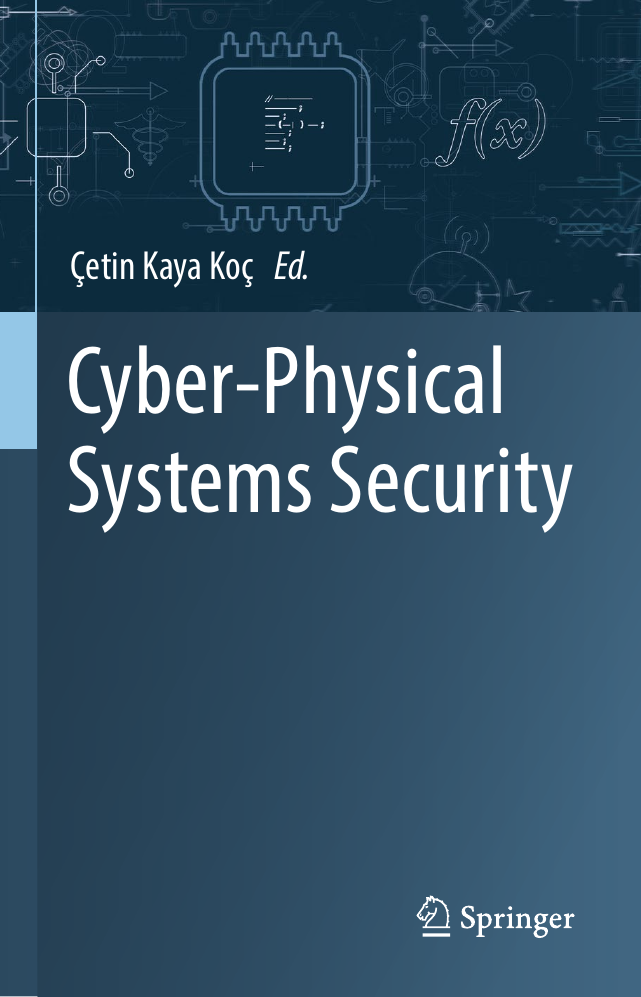
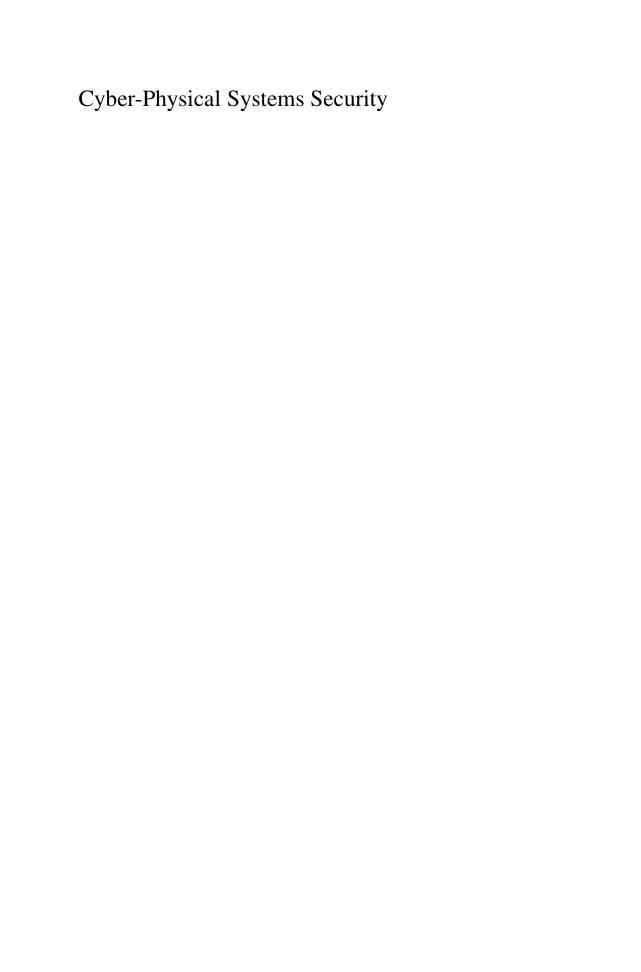
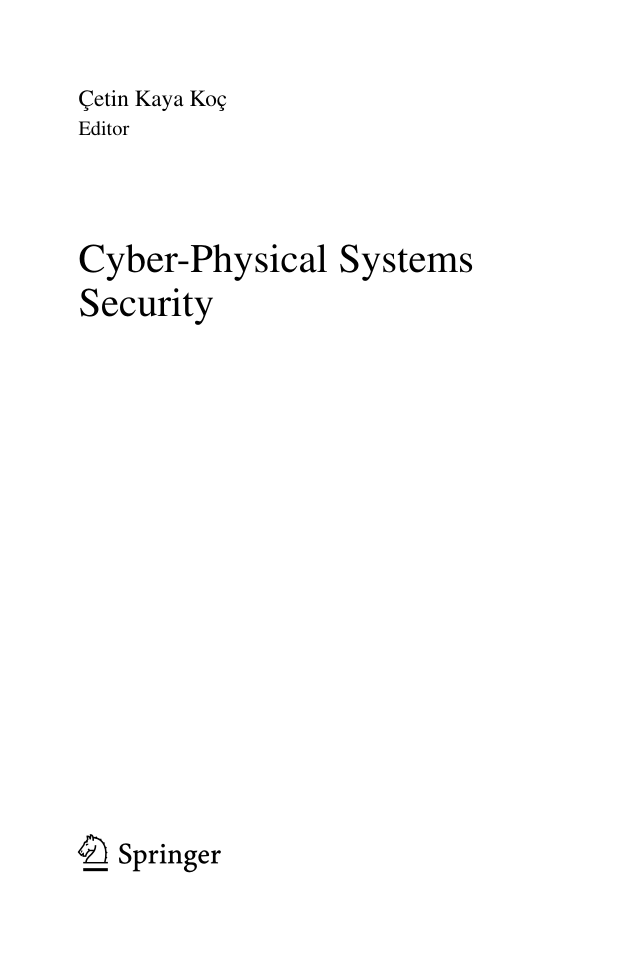
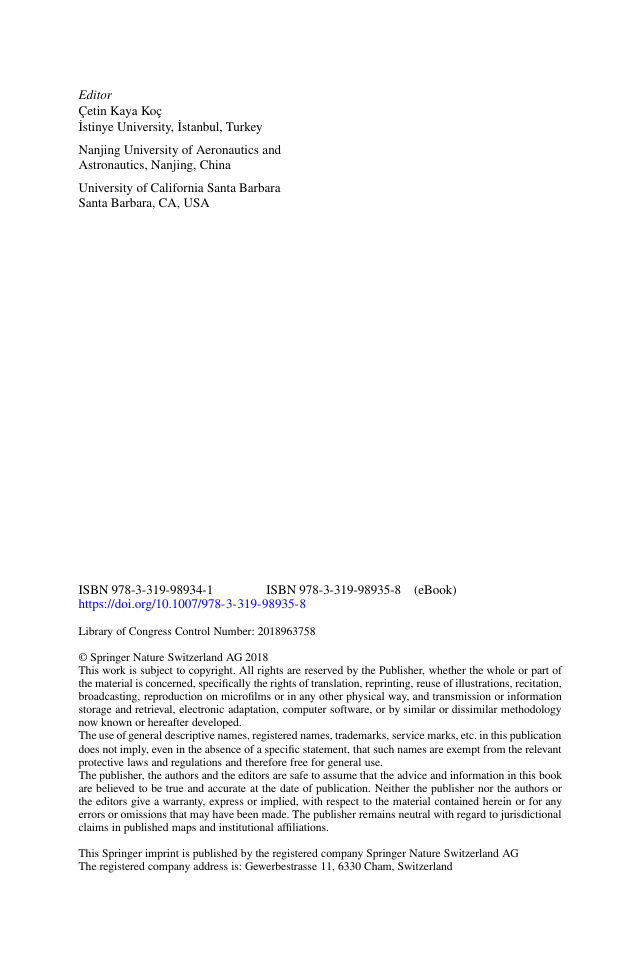
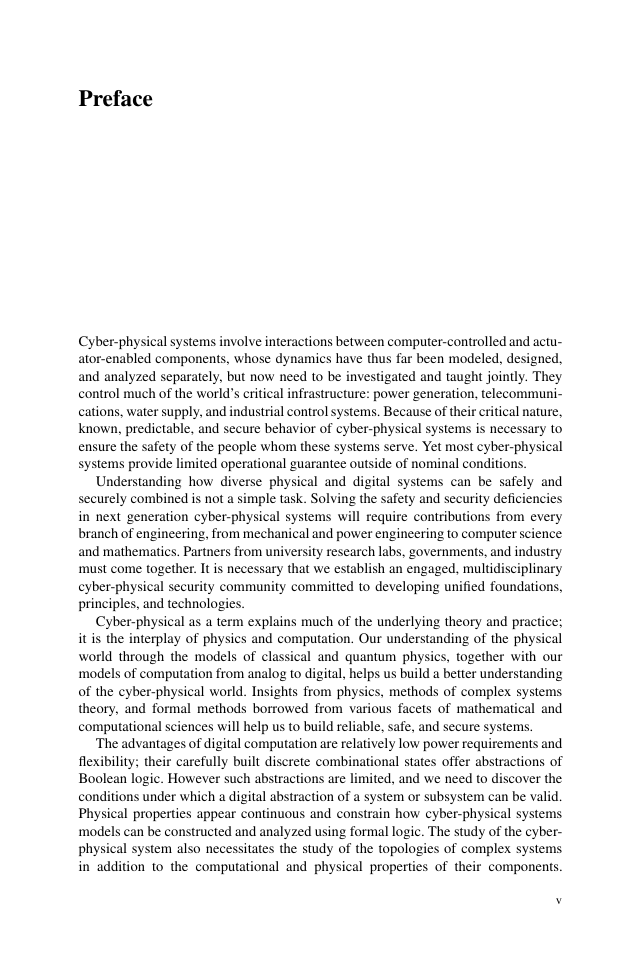
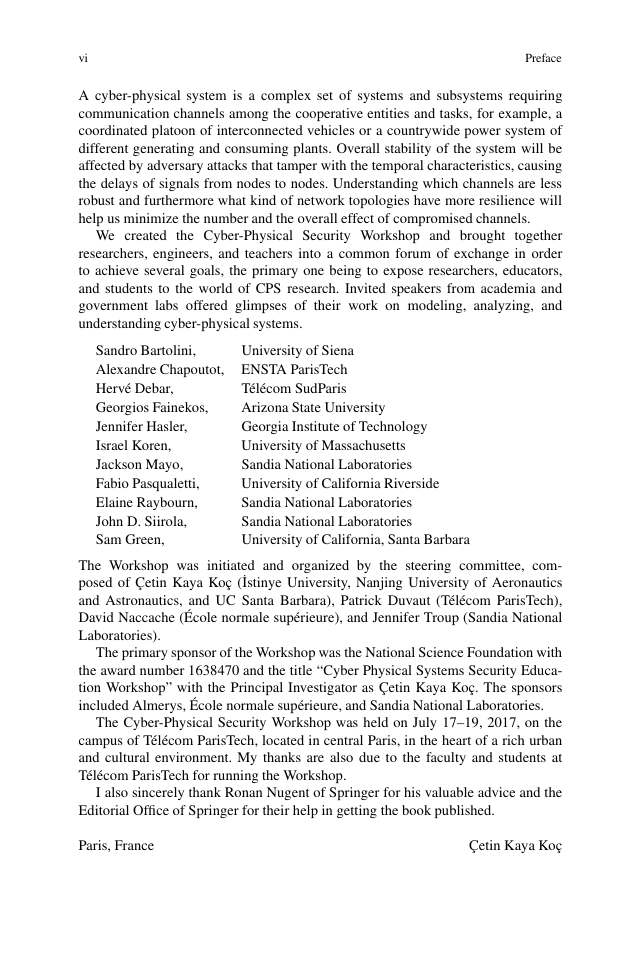
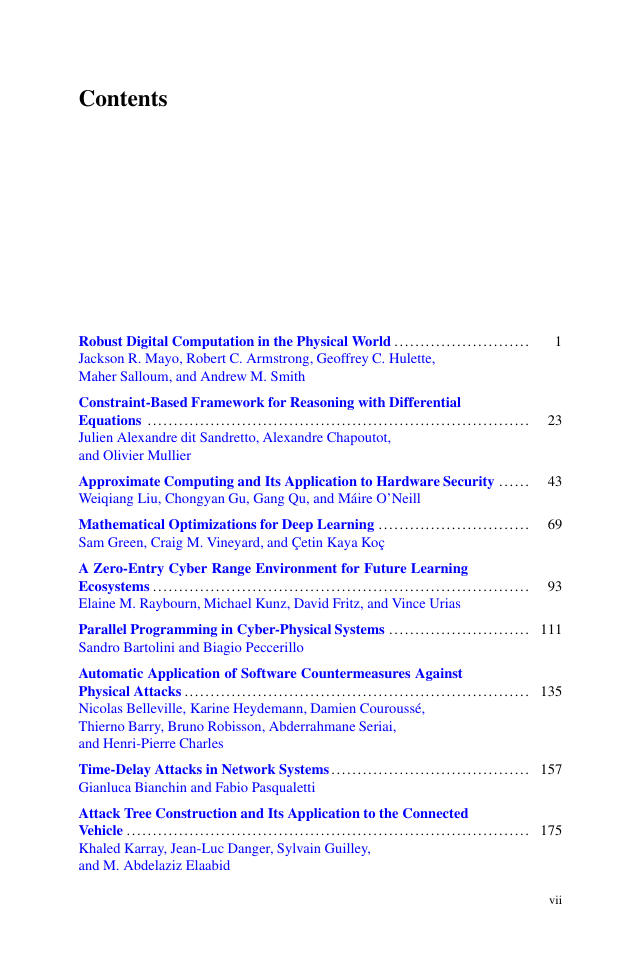
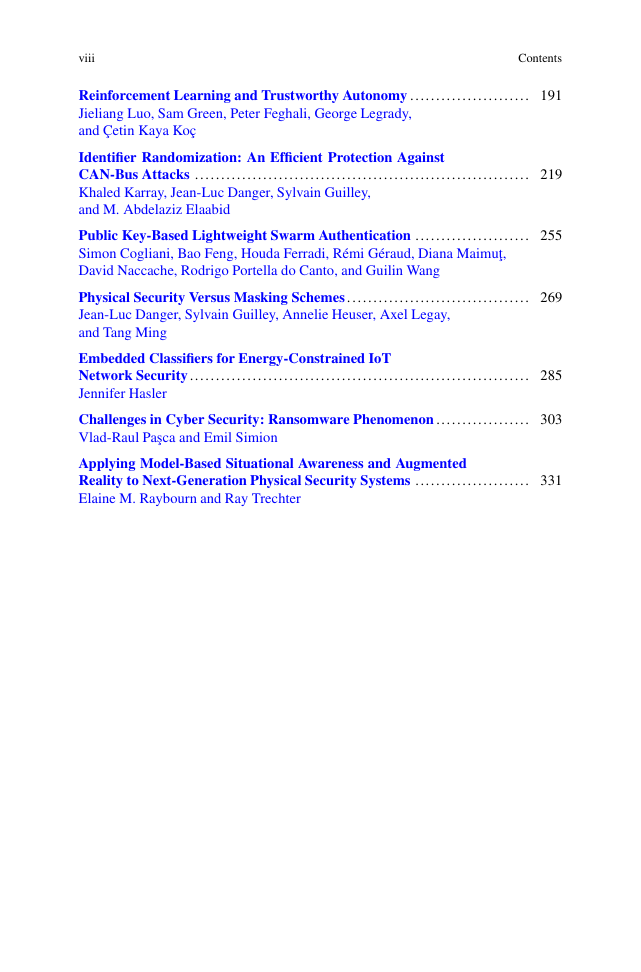








 2023年江西萍乡中考道德与法治真题及答案.doc
2023年江西萍乡中考道德与法治真题及答案.doc 2012年重庆南川中考生物真题及答案.doc
2012年重庆南川中考生物真题及答案.doc 2013年江西师范大学地理学综合及文艺理论基础考研真题.doc
2013年江西师范大学地理学综合及文艺理论基础考研真题.doc 2020年四川甘孜小升初语文真题及答案I卷.doc
2020年四川甘孜小升初语文真题及答案I卷.doc 2020年注册岩土工程师专业基础考试真题及答案.doc
2020年注册岩土工程师专业基础考试真题及答案.doc 2023-2024学年福建省厦门市九年级上学期数学月考试题及答案.doc
2023-2024学年福建省厦门市九年级上学期数学月考试题及答案.doc 2021-2022学年辽宁省沈阳市大东区九年级上学期语文期末试题及答案.doc
2021-2022学年辽宁省沈阳市大东区九年级上学期语文期末试题及答案.doc 2022-2023学年北京东城区初三第一学期物理期末试卷及答案.doc
2022-2023学年北京东城区初三第一学期物理期末试卷及答案.doc 2018上半年江西教师资格初中地理学科知识与教学能力真题及答案.doc
2018上半年江西教师资格初中地理学科知识与教学能力真题及答案.doc 2012年河北国家公务员申论考试真题及答案-省级.doc
2012年河北国家公务员申论考试真题及答案-省级.doc 2020-2021学年江苏省扬州市江都区邵樊片九年级上学期数学第一次质量检测试题及答案.doc
2020-2021学年江苏省扬州市江都区邵樊片九年级上学期数学第一次质量检测试题及答案.doc 2022下半年黑龙江教师资格证中学综合素质真题及答案.doc
2022下半年黑龙江教师资格证中学综合素质真题及答案.doc